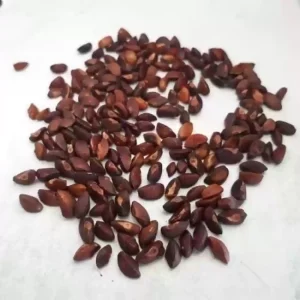Sage Broad Leaved Seeds
Sage Broad-Leaved Seeds (Salvia officinalis) is a perennial herb known for its large, aromatic leaves, which are widely used in cooking and herbal remedies. This variety of sage has broader leaves compared to the more common garden sage and is favored for its strong flavor and ease of cultivation. Broad-leaved sage is commonly grown in herb gardens and is a staple in Mediterranean and European cuisines, where it”s used to season meats, sauces, and stuffing.
Growing Conditions for Sage Broad Leaved Seeds:
- Light:
- Sage thrives in full sun, requiring at least 6 hours of direct sunlight each day. It can tolerate partial shade but may produce fewer leaves and a weaker flavor in lower light conditions.
- Soil:
- Sage prefers well-draining soil that is slightly sandy or loamy with a pH between 6.0-7.0. It doesn’t tolerate heavy, clay soils or waterlogged conditions. Amending the soil with compost or sand improves drainage and nutrient content.
- Watering:
- Once established, sage is relatively drought-tolerant. Water moderately, allowing the soil to dry out between waterings. Overwatering can lead to root rot, so it\’s important to avoid soggy soil.
- Temperature:
- Broad-leaved sage grows best in temperate climates with warm summers and mild winters. It can tolerate cold temperatures but should be protected from frost in extremely cold regions. In zones 5-9, sage is usually hardy.
Care and Maintenance of Sage Broad Leaved Seeds:
- Fertilization:
- Sage does not require heavy feeding. An annual application of compost or a balanced organic fertilizer in early spring is usually sufficient to support healthy growth.
- Pruning:
- Regularly prune sage to encourage bushy growth and to prevent the plant from becoming woody. After flowering, cut back the stems by about one-third to maintain a compact shape. Deadheading (removing spent flowers) also helps prolong the plant’s productivity.
- Mulching:
- Apply a layer of mulch around the base of the plant to help retain moisture and suppress weeds. In colder climates, mulching can also protect the roots from freezing temperatures.
- Pest Control:
- Sage is relatively pest-resistant but can occasionally attract aphids, spider mites, or whiteflies. Regular inspection and treating infestations with neem oil or insecticidal soap will help keep pests at bay.
- Disease Control:
- Sage is susceptible to fungal diseases, particularly in humid conditions or if the plant is overwatered. Ensure good air circulation around the plant and avoid overhead watering to prevent fungal issues like powdery mildew.
Harvesting Sage Broad Leaved Seeds:
- Timing:
- You can start harvesting sage leaves once the plant is well-established, usually after it reaches 6-8 inches in height. The best time to harvest is in the morning after the dew has dried, when the essential oils are most concentrated.
- Method:
- Snip leaves as needed, cutting just above a leaf node (where the leaves join the stem) to encourage new growth. Avoid removing more than one-third of the plant at a time to allow the plant to continue growing.
- Drying:
- Sage leaves can be used fresh or dried for later use. To dry, tie small bundles of sage together and hang them upside down in a warm, dry place with good air circulation. Once dry, store the leaves in an airtight container away from light.
Culinary Uses of Sage Broad Leaved Seeds:
- Flavor Profile:
- Sage has a strong, earthy, and slightly peppery flavor with hints of lemon and eucalyptus. The broad-leaved variety offers a slightly milder flavor than common garden sage.
- Uses:
- Stuffing and Sauces: Sage is a key ingredient in stuffing recipes, especially for poultry. It also pairs well with butter, cream-based sauces, and roasted vegetables.
- Meats: Sage complements rich meats like pork, lamb, and sausage. It can be used in marinades, rubs, or as a seasoning for roasting.
- Herbal Teas: Sage leaves can be steeped in hot water to make a soothing herbal tea that aids digestion and has anti-inflammatory properties.
Medicinal Benefits:
- Digestive Aid: Sage has traditionally been used to aid digestion, reduce bloating, and treat indigestion.
- Antioxidant and Anti-inflammatory: Sage contains several antioxidants and anti-inflammatory compounds, including rosmarinic acid, which supports overall health.
- Cognitive Function: Sage has been studied for its potential benefits in improving memory and cognitive function.








Reviews
There are no reviews yet.